Motivational factors that managers must be proficient
- Interesting work;
- Good wages;
- Full appreciation of work done;
- Job security;
- Good working conditions.
In a study by Lindner (1998), it was established that the most important motivating factors were interesting work, good wages, full appreciation of work done, job security and good working conditions (Casserly, 2013). Lindner concluded that any manager that wished to enhance motivation in an organization had to consider Maslow’s theory of needs. He noted that “interesting work, physiological, safety, social, and esteem factors must first be satisfied” (Lindner, 1998). Further, employees considered good pay as the second most important motivational factor and thus managers had to consider it (Lindner, 1998). This observation did not follow Maslow’s theory because different motivational factors could be found mixed in various levels. That is, motivational factors did not ascend from lower levels to higher levels, but instead they were mixed up in the hierarchy.
- Promotions and growth in the organization;
- Feeling of being in on things;
- Personal loyalty to employees;
- Tactful discipline;
- Sympathetic help with personal problems.
The manager must however observe that motivational factors may differ or provide different results based on the strategy used. Hence, managers must understand how motivation works in their organizations. For instance, different researchers, such as Hertzberg, Adams and Vroom, have found that these motivational factors may assume different positions when ranked.
Motivation, which is defined as inner force that compels employees to accomplish personal and organizational goals, also includes other elements such as promotion and growth, feeling of being in control, employee loyalty, tactful discipline and sympathy. Managers are therefore encouraged to consider all these elements when implementing motivational factors for different employees because employee needs are met differently (Daft, 2014).
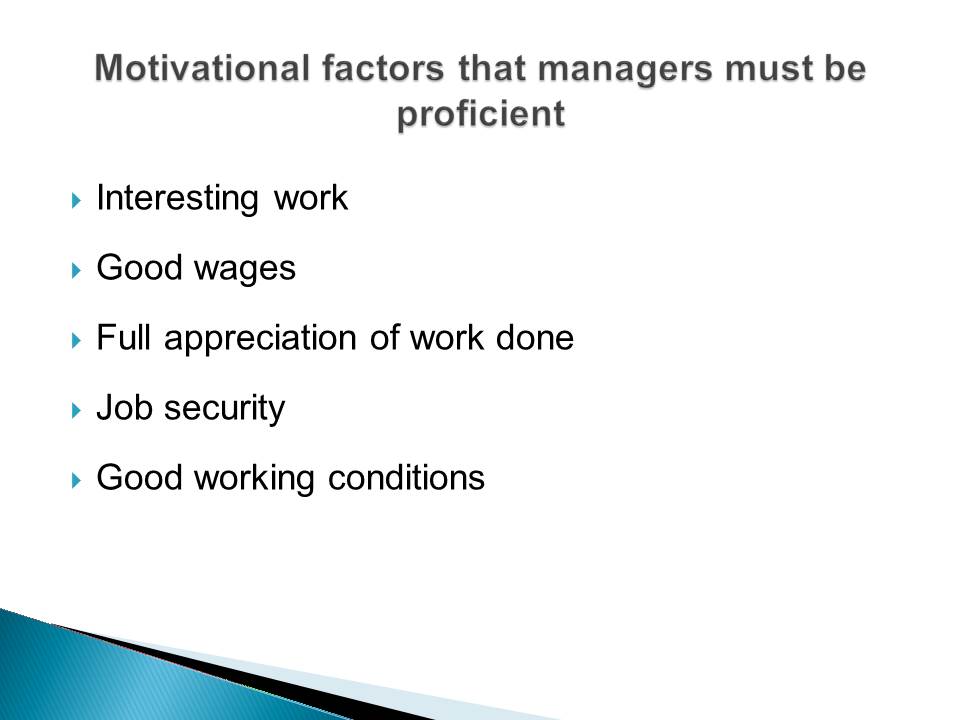
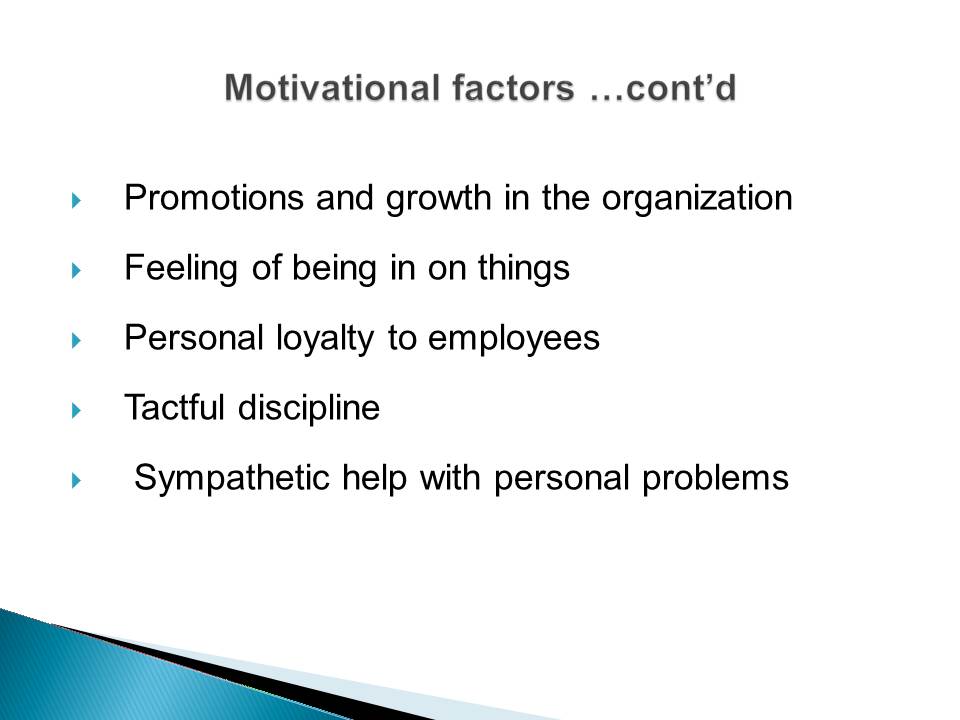
Does motivation come from within a person, or is it a result of the situation? Explain cognitive evaluation theory
Extrinsic Motivation:
- The task does not offer direct motivation;
- Expects some form of extrinsic reward e.g., pay, promotion;
- Cost verse benefit scenario;
- Rewards are greater than the cost;
- Great extrinsic reward required.
Scholl (2002) has identified three types of motivation. Type I motivation is extrinsic motivation or pure extrinsic motivation. Employees engage in tasks that do not provide any direct motivation. These tasks may appear to be natural or distasteful but they perform them because of extrinsic rewards such as promotion, increased pay, time off or good rating. In this type of motivation, employees consider task engagement as a cost with related expected extrinsic reward as benefit. This type of motivation may only take place when employees consider the reward as greater relative to cost. Thus, the great extrinsic reward may make employees to engage in more physically or emotionally unpleasing tasks (Scholl, 2002).
Intrinsic Outcome Motivation:
- Performance or achievement leads to intrinsic satisfaction;
- May include self-concept external motivation, self-concept internal motivation, or goal identification;
- For external validation, self-concept external motivation is involved;
- Failed expected intrinsic satisfaction leads to declined motivation.
Intrinsic Process Motivation:
- Tasks performed regardless of the outcome or expected results;
- Tasks performed for continued enjoyment or pleasure.
Type II motivation is an intrinsic outcome motivation. Tasks can be undesirable, but employees engage in them because they expect some form of intrinsic satisfaction (Scholl, 2002). Intrinsic motivation expected could be “self-concept external motivation, self-concept internal motivation, or goal identification” (Scholl, 2002). Conversely, self-concept external motivation is involved when employees perform tasks for external validation. For validating own expectations, employees engage in undesirable tasks to meet their validate self-perceptions of values or competency. Employees who engage in tasks because they believe others will benefit are motivated by goal internalization. Costs are inherent in task performance, but must be overcome by external validation, internal validation, or goal internalization when others benefit. However, when expected intrinsic satisfaction fails, this type of motivation declines.
Type III motivation or Intrinsic Process Motivation are tasks performed irrespective of the expected outcomes. Employee may engage in such activities simply because of the expectation of continued enjoyment or pleasure (Scholl, 2002).
Cognitive Evaluation Theory:
- Attempts to demonstrate the effects of external consequences on internal motivation;
- Tasks are interesting to employees;
- Tasks with greater perceived competence will enhance intrinsic motivation and vice versa;
- Intrinsic motivation may decline over time due to repetitive actions;
- Functional significance of the task is imperative;
- Unexpected tangible rewards or freely given rewards are not detrimental to motivation and satisfaction;
- Positive feedback is good but should not provided in controlling way;
- Rewards should not be known prior to the task.
Cognitive Evaluation Theory attempts to explain the impacts of external consequences on internal motivation (Deci, Koestner, & Ryan, 1999). Tasks that result in greater perceived competence do increase intrinsic motivation. Conversely, tasks with low perceived competence result in declining intrinsic motivation. The theory assumes that tasks are interesting to employees.
It has also been established that intrinsic motivation may decline over time because of several repetitive actions and rewards. That is, same tasks may decrease the level of motivation but not external forces. Any rewards or positive feedback delivered in a controlling manner may ultimate lead to decline in intrinsic motivation. With these known facts, managers should not let employees to know tangible rewards beforehand because they may not be effective.
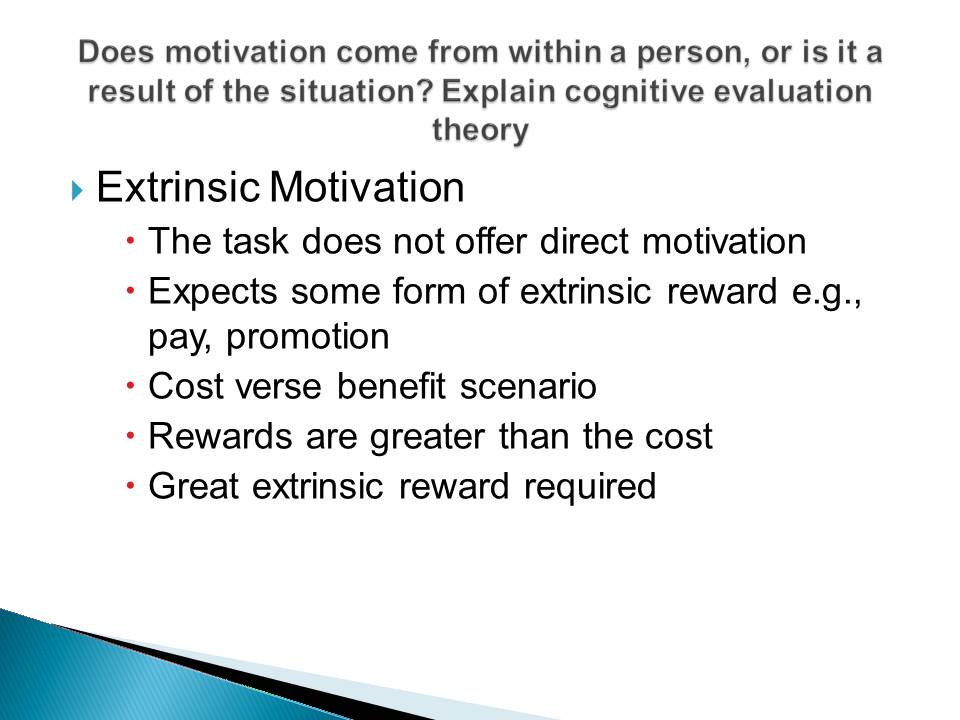

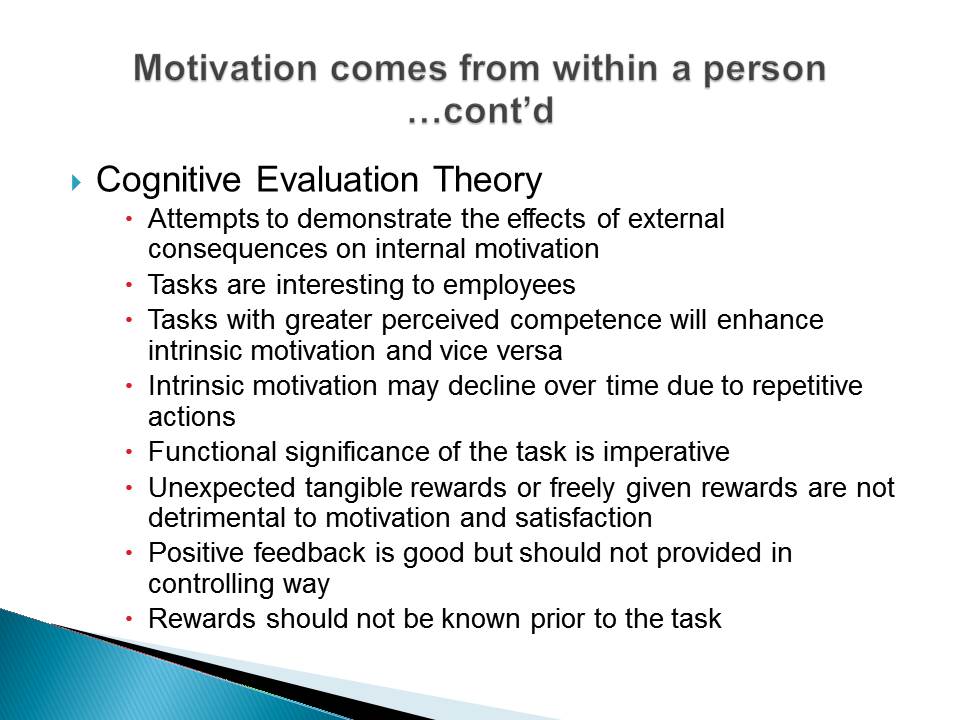
How applicable is motivation to management practice and leadership style?
- Leadership/management style influences level of motivation;
- Leadership, ambitions and social factors influence motivation;
- Command-and-control is bad for motivation;
- Worker responsibility enhances motivation.
It is imperative to note that management styles vary significant and therefore the influences on motivation. Generally, management styles affect employee level of motivation. However, personal factors like changing ambitions, leadership styles, and social circles also influence motivation. Command-and-control management style negatively impacts motivation, whereas employee own responsibility drive their ambition. In this respect, employees who are self-motivated or visionaries will not work with command-and-control managers. They will find other means to escape from such leadership styles. This style also applies to high-level of supervision (Weiss, 2001).
Team-driven management style also promotes motivation. Employees are inspired and strive for dependency and acceptance among other teammates. Coworkers may influence motivation and is usually low-level motivation because of desire to be like others for acceptance.
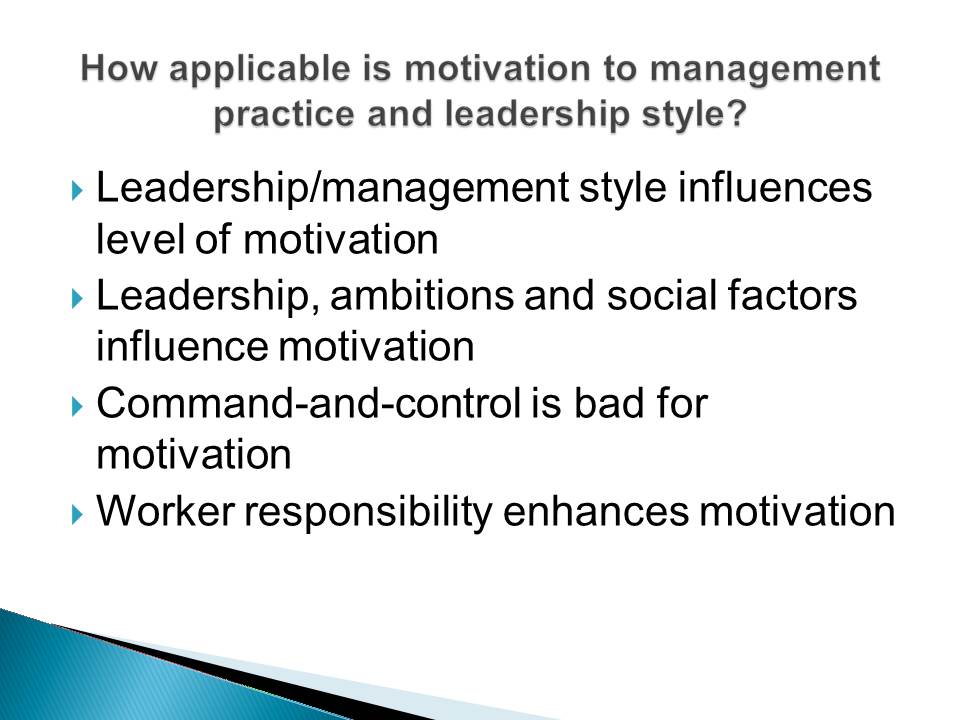
What is the role of self-efficacy in goal setting?
Self-efficacy is perceived capabilities.
It influences:
- Choice of activities;
- Effort expended;
- Persistence.
Low self-efficacy may lead to task avoidance.
Efficacious employees may engage in tasks.
Self-efficacious employees may demonstrate long persistence and expend greater efforts.
Self-efficacy is shown to influence “choice of activities, effort expended, and persistence” (Schunk, 1990). In this case, employees who possess low-levels of self-efficacy for work may strive to avoid tasks while those who consider themselves as efficacious will most likely engage in tasks. During task difficulties, self-efficacious employees will demonstrate or expend improved efforts and perseverance longer than other workers who do not believe in their abilities.
Locus of control shows perceived control on outcomes among employees. Individuals have different perceptions about occurrence of outcomes, i.e., whether they take place independently of their behaviors (external control) or outcomes are influenced by perceived behaviors (internal control). In this case, positive outcome expectations are considered relevant, but they may not necessarily translate into behaviors. Employees who expect praise (positive outcome expectation) from their managers may not put much effort in tasks if they doubt their abilities to succeed in a given tasks (low self-efficacy).
Effects of goals on behavior depend:
- Specificity;
- Proximity;
- Difficulty level.
Goals should have specific performance standards.
Specific goals promote self-efficacy.
Goals influence behaviors but such influences depend on “specificity, proximity, and difficulty level” (Schunk, 1990). Goals should be designed with specific performance standards to enhance inputs and promote self-evaluation and vaguely stated goals. Managers should expect workers to increase performance when they have specific goals to achieve. Greater specification determines effort needed to succeed and employee self-satisfaction expected. Hence, specific goals enhance self-efficacy because achievements are easy to gauge.
When managers define goals as proximal rather than distant, they create greater motivation among employees. Employees can track progress toward proximal goals easily while their perceived outcomes result in increased self-efficacy. Workers may initially perceive goals as difficult and doubt their abilities to succeed, but striving to achieve expected outcomes enhances self-efficacy.
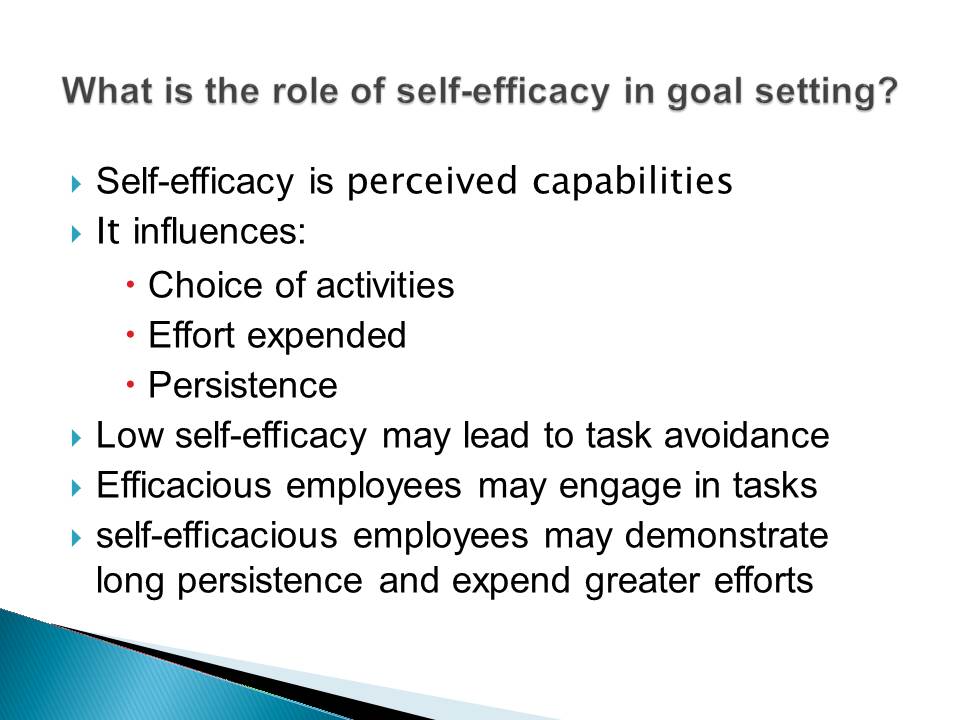
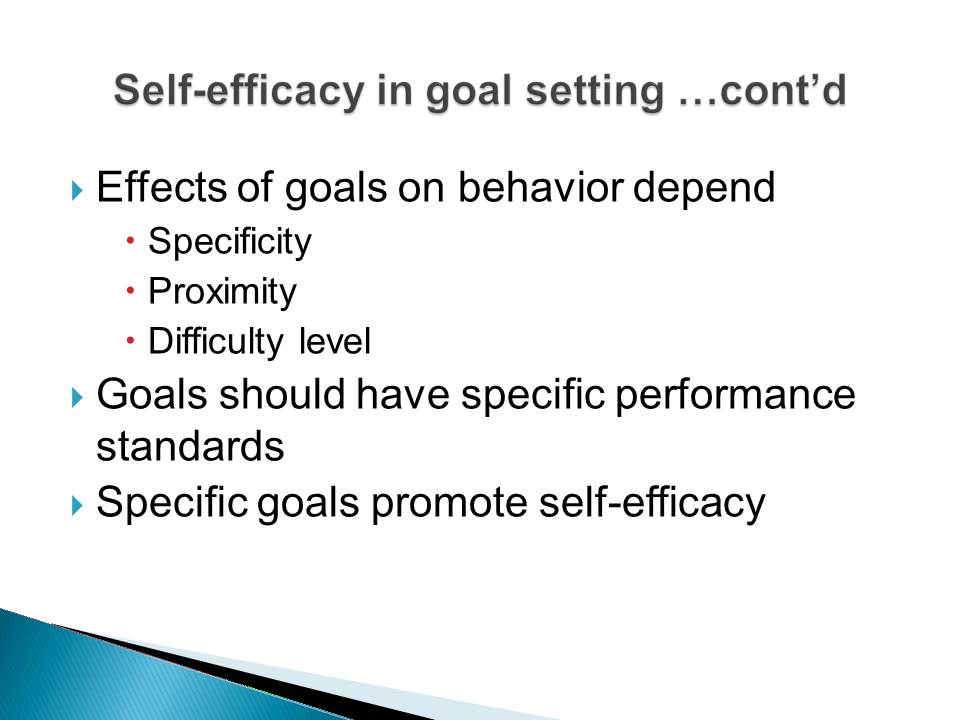
What are the variables in expectancy theory?
Expectancy theory shows how individuals make choices among behavioral alternatives.
Motivational Force (MF) , the behavior chosen.
It variable include:
- Expectancy;
- Instrumentality;
- Valence.
Expectancy theory reflects how individuals choose to certain behaviors among several alternatives (Scholl, 2002). For instance, employees have to choose between two critical strategic objectives to implement. This leads to the concept of Motivational Force (MF). Based on Motivational Force, employees will develop preference for certain alternative behaviors. Hence, the chosen behavior must have high motivational force. MF reflects the case of two cognitions and a single value.
The three variables are expectancy, instrumentality, and valence. Expectancy shows the belief in efforts to achieve the desired performance. Instrumentality posits that high performance will result in improved reward while valence shows employee preference for every potential outcome (Scholl, 2002).
- Motivational Force (MF) = Expectancy * Instrumentality * Valance;
- MF should not be zero;
- Any variables should not be zero;
- A person’s experience may experience expectancy and instrumentality.
The motivational force strives to demonstrate that multiplicative association is that any zero variables would negatively impact performance. Hence, there will not be any drive for employees to engage in tasks. For instance, if either of the following facts is evaluated, then motivational force to perform a task would be zero and therefore workers would lack the drive to perform any job (Scholl, 2002):
- Low expectancy: employees may believe that irrespective of their hard work, no performance would increase.
- Low instrumentality: employees may believe that notwithstanding their improved efforts, the outcomes would stay remain the same.
- Low valance: employees lose interests and do not care about task outcomes.
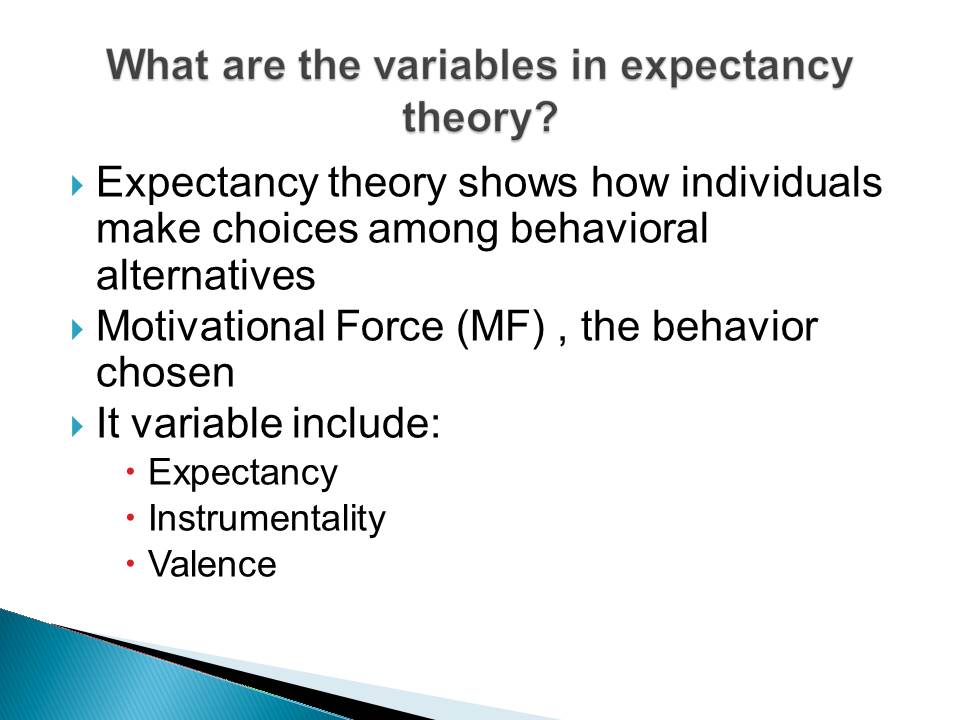
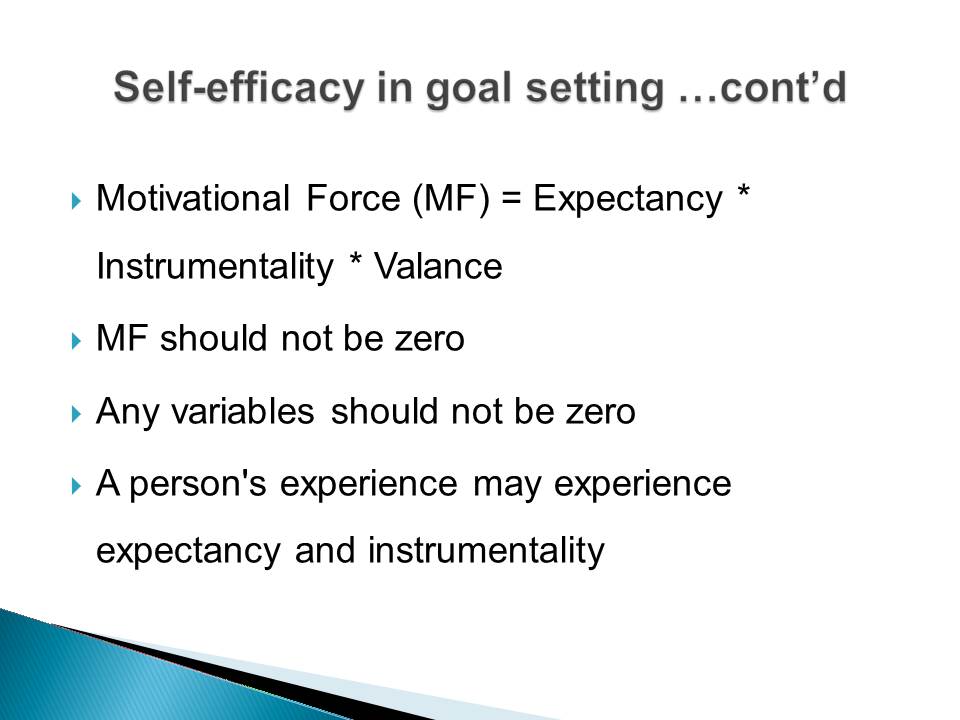
Interactive Activities for Participants
- Question & answer: based on the learned materials;
- Case study on managers and motivation;
- Brainstorming for new ideas to solve motivational challenges;
- Participants take part to describe their managerial styles;
- Participants talk about their experiences, failures and achievements.
These interactive activities are meant to enhance learning and retention of learned concepts.
- Neighbor Nudge: participants ask their neighbors to summarize course contents;
- Participants compare notes on their views about interesting aspects of the course;
- Analogy: relate motivation to real life experiences;
- Management role play.
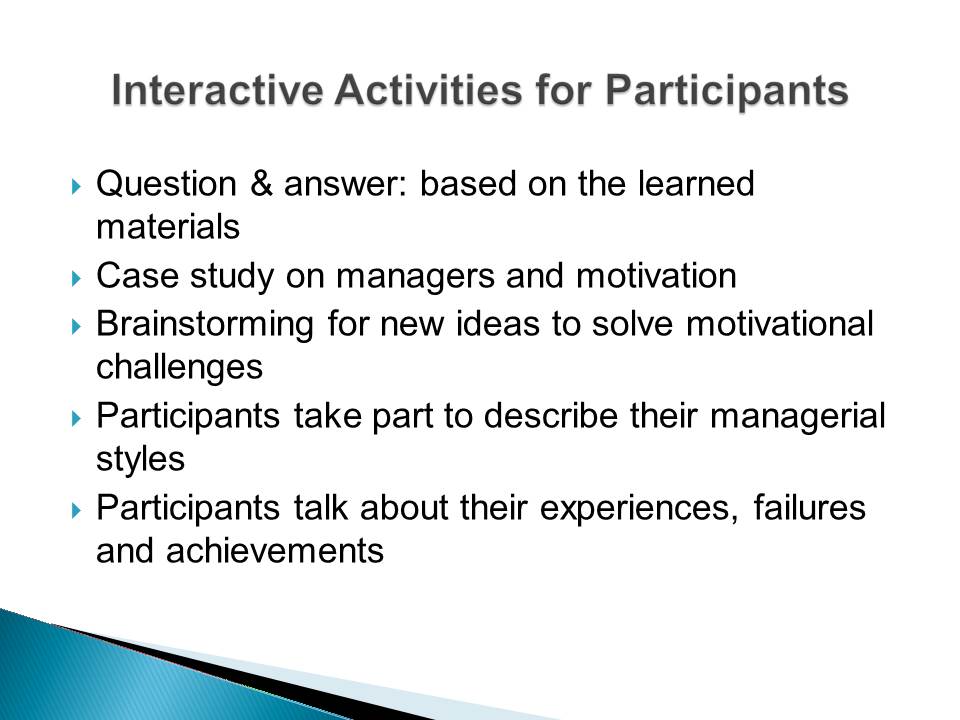
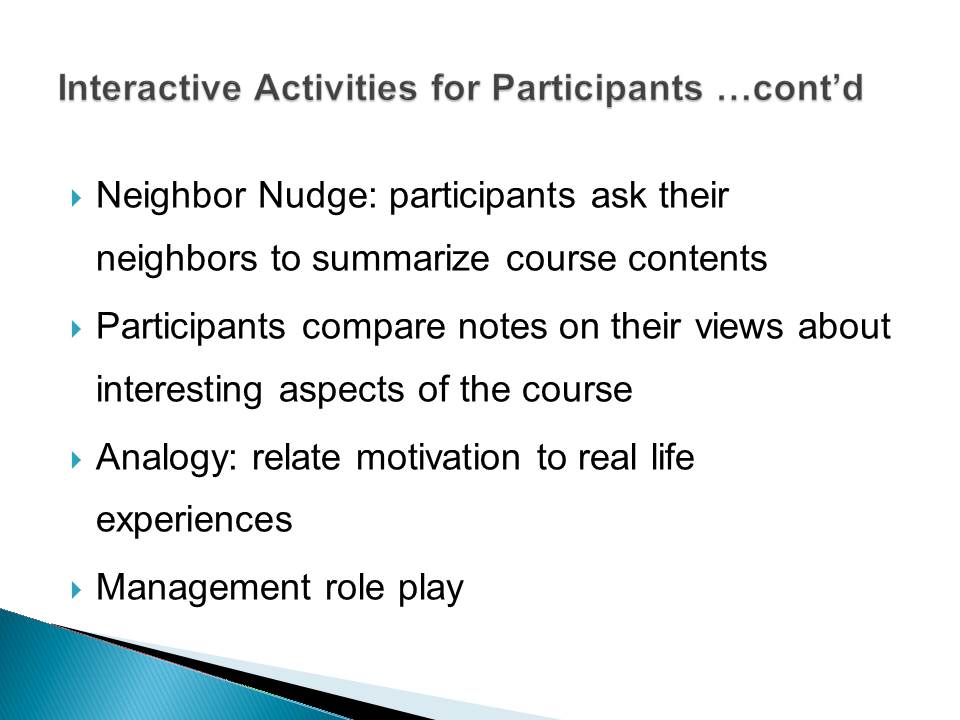
References
Casserly, M. (2013). Master Class: America’s Top CEOs On The Secrets Of Motivating Employees. Forbes. Web.
Daft, R. L. (2014). Management (11th ed.). Mason, OH: South-Western, Cengage Learning.
Deci, E. L., Koestner, R., & Ryan, R. M. (1999). A meta-analytic review of experiments examining the effects of extrinsic rewards on intrinsic motivation. Psychological Bulletin, 125, 627-668.
Lindner, J. R. (1998). Understanding Employee Motivation. Journal of Extension, 36(3).
Scholl, R. W. (2002). Work Motivation Overview. Web.
Schunk, D. H. (1990). Goal setting and self-efficacy during self-regulated learning. Educational Psychologist, 25, 71-86.
Weiss, W. H. (2001). Building morale, motivating and empowering employees. Supervision, 62(1), 3.